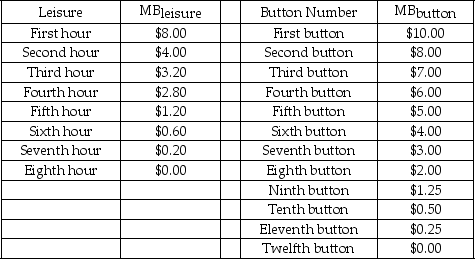Multiple Choice
Scenario: This problem applies the principle of optimization covered in Chapter 5 to the problem of choosing how many hours to work. Paul has to decide how many hours to work per day. His boss is willing to give Paul whatever hours Paul wants up to 8 hours. All else being equal, he would rather not work, that is, Paul has positive marginal benefit from each hour of leisure. But he is an avid collector of presidential campaign buttons. The more leisure he takes, the fewer buttons he can afford. So Paul faces a trade-off between leisure and buttons. Each button costs $1.00. The table below shows Paul's marginal benefits from leisure (MBlₑᵢsᵤᵣₑ) and buttons (MBbᵤttₒn) .

-Refer to the scenario above.If the hourly wage is $1.00,how many hours would Paul choose to work? How many buttons would he buy?
A) 6 hours; 6 buttons
B) 3 hours; 3 buttons
C) 2 hours; 2 buttons
D) 0 hours; 0 buttons
Correct Answer:

Verified
Correct Answer:
Verified
Q117: The figure below shows output of a
Q118: An employer discriminating against Asian workers is
Q119: Without any change in the supply of
Q120: All of the following are research studies
Q121: The figure below shows output of a
Q123: Refer to the scenario above.Trevor argues that
Q124: The following table shows the output of
Q125: Since 1967,there has not been much of
Q126: If both the goods and the labor
Q127: Suppose a firm uses land,labor,and capital for